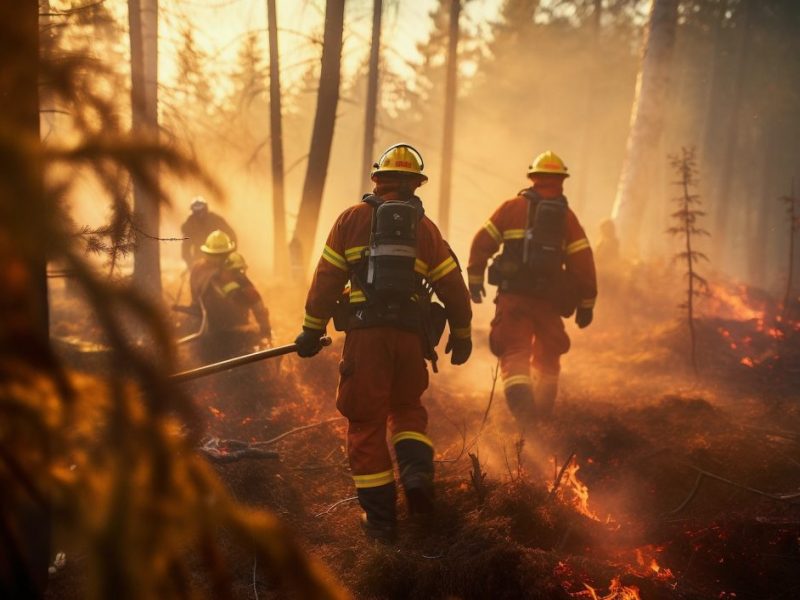NAU expert fights fire with research | The NAU Review
Are Arizona’s firefighters in it for the long haul—or is the Grand Canyon State grappling with employee retention challenges that could endanger citizens when emergencies or wildfires strike?
State leaders recently tapped one NAU expert to help answer that question: Dierdra Bycura, chair of the Department of Health Sciences and an associate professor in the Fitness Wellness degree program.
Working with a handful of experts from the Economic Policy Institute within The W. A. Franke College of Business—including Shuo Liu, Feifei Zhang, Osei Akoto Kwarteng, and director Nancy Baca—Bycura designed a survey that asked firefighters questions about how they came into the profession, how long they planned to stay, and why they may someday leave. The economists on the team also conducted an in-depth analysis of employee data from the Arizona Public Safety Personnel Retirement System collected from 2017 to 2023 to identify patterns in recruitment, retention, retirement, and pay.
The team found that most firefighters in Arizona are content with their jobs. A whopping 95% of those surveyed reported they intended to stay in the profession until retirement. They cited job security as the main motivation to stay, followed by the sense of purpose they felt while helping others, the camaraderie with colleagues, and the challenging and exciting nature of the work.
Those who did leave the profession, Bycura said, cited pay as the top reason—and more than a quarter of the current firefighters surveyed said they were dissatisfied with their annual base salary.
But firefighters’ main reasons for dissatisfaction differed by geography: those who worked in rural areas were more likely to cite pay and benefits as a major reason for turnover in their districts, while those in urban areas were more likely to cite sleep deprivation, stress, impacts on family life, and exposure to chemicals.
“We know stress levels and mental health issues are on the rise more broadly,” Bycura said. “Our results indicated this to be true in the firefighter population as well. They’re saying the reasons for the increase in stress levels are things like higher call volumes than in previous years and the more frequent need to work overtime when colleagues call in sick.”

A statewide partnership
Bycura was tapped by the state shortly after the Arizona Legislature passed Senate Bill 1268 in 2022. The bill required stakeholders of the Public Safety Personnel Retirement System to report to the governor and legislature on recommendations to improve the retention and recruitment of public safety employees, including police, sheriffs, and fire service personnel.
In response, a working group of government and employee organization leaders, appointed by the PSPRS advisory committee, engaged the Arizona Board of Regents to fund collaborative research teams at each of the state’s three public universities. The group asked a team at Arizona State University to survey leaders such as city managers and station chiefs on how public perception, leadership style, and other factors influence recruitment and retention. Meanwhile, researchers at the University of Arizona conducted a survey of police officers and members of the public across the state to measure officer satisfaction, citizens’ trust and perceptions of safety, and more.
It makes sense that the working group called upon Bycura to lead a study on the state of firefighter retention and satisfaction across Arizona: she understands what makes firefighters tick.
As a health researcher, Bycura has spent years studying how to improve fire service workers’ cardiovascular health on the job, as cardiovascular disease accounts for an estimated 45% of on-duty deaths. She recently guided the work of PhD graduate Anthony Santos on an intervention study that aimed to improve depression, post-traumatic stress disorder, psychological resilience, and mental well-being in the fire service sector. To boot, she’s married to a longtime Arizona firefighter who recently retired.
“I’m committed to the profession, both professionally and personally,” Bycura said. “I’ve spent time studying what draws people into the fire service and what keeps them there, like the sense of purpose, the camaraderie, and the generous pension.”
The researcher said her collaborators, all experts from the Economic Policy Institute, were no less important in creating the report, which could have broad implications for statewide policy.
“It was a collaborative partnership,” Bycura said. “What I brought to the table was an understanding of firefighter culture and a lot of connections in that community. What they brought to the table was advanced statistical analysis of our survey data. We needed each other to do this well.”
The full, multi-university report, “Recruitment and Retention of Arizona’s Law Enforcement and Fire Service Personnel,” is available to read on Arizona State University’s website.
As seen in The NAU Review.

